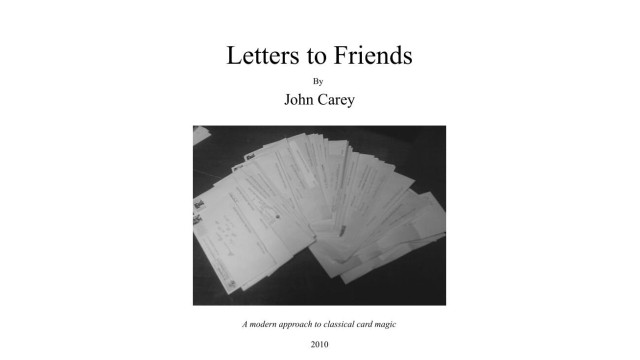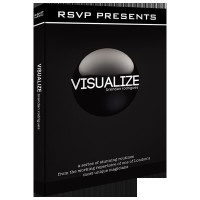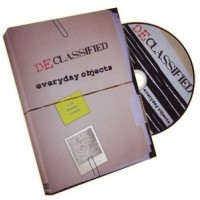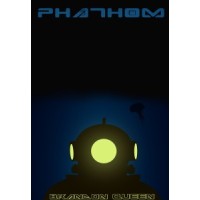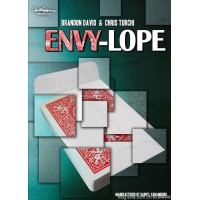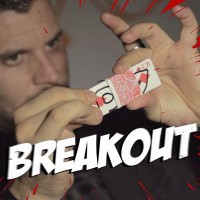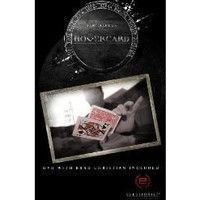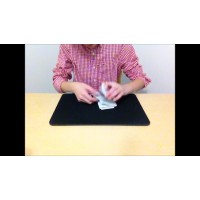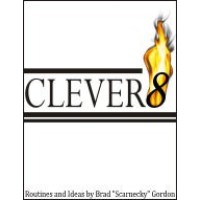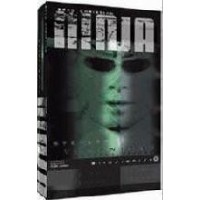Letters To Friends by John Carey
- Product Code: T0462
- Reward Points: 10
- Availability: In Stock
- $5.99
-
$2.99
- Price in reward points: 299
Reviews (0)
Related Products
Card Dupery Book by J.K. Hartman
J.K. Hartman - Card Dupery BookPDFWhen Hartman meets your deck, first he will teach it to talk-then ..
$2.99 $6.68
Isabellas Star by David Sena & Peter Turner
David Sena & Peter Turner - Isabellas StarPDFThe performer after talking to the audience about a..
$1.99 $4.99
Working Nine To Five For Gilbreath by Art Vanderlay
Whilst seated around a dinner table, one of your guests requests for you to show them some of your a..
$0.99 $6.28
Pre Deck Ability by Aldo Colombini
An unbelievable prize winning routine with a regular deck of cards! A stunning self-working rout..
$1.99 $4.99
Reveries by Nick Conticello
Here we offer three new approaches to Bob Hummer's classic Mindreader's Dream effect. A ..
$2.99 $6.72
Pyramid Prophecies by Nick Conticello
This ebook is a bit of a departure for me. The material is mathematical, but it need not be pe..
$3.99 $8.29
Black Dot by Chaco Yaris And Magik Time
An incredible effect with your own baseball cap! A spectator selects any card and it is lost back in..
$2.99 $5.58
The Real Caan by Dan Bond
Effect: A spectator calls out a card, another spectator calls out the number, all free choice. The m..
$1.99 $6.21
Cut To The Chase
Your spectator cuts to two separate positions in a shuffled deck. They then have a COMPLETELY FREE C..
$3.99 $7.77
Mint by Area52
The Invisible Deck. Reimagined from scratch. The Invisible Deck is a classic in magic. The spectator..
$2.99 $5.98
Spectator Torn And Restored To Envelope by Andrew Dean
The spectator freely selects an envelope then a card from a deck of cards. They then follow your ins..
$1.99 $4.98
Exact by Priyanshu Goel
Priyanshu goel a 14 year old magician releases one of his favouraite trick which he love to perform ..
$1.99 $4.98
All Back Aces by Prasanth Edamana
A powerful packet trick that ends clean and is examinable at the end. First, 5 cards have no faces -..
$1.69 $4.58
The Trick That Can Be Explained by Mark Elsdon
Effect: The performer introduces a small envelope and shows that there is a playing card inside..
$1.69 $4.98
Gum Stick Trick by Magic Trick Mike
From the creator of Revise 5! Gum Stick Trick (GST) is a perfect companion trick to go with Revise 5..
$2.99 $5.98
E C A by Jesper Tseng
The plot is simple: A thought of card teleports from one packet to another without any sleights, gim..
$1.69 $3.98
Inner Deception by Itsallanillusion
Imagine a card trick where they freely choose ant card, they shuffle the cards face up into face dow..
$2.99 $5.98
Little Love by Agustin
Magic is art. This time you can show it.Take a piece of paper and fold it. In seconds the paper turn..
$1.69 $6.95
Women In Boxes
About Magic Assistants. The one who distorts her body into impossible positions while the magician c..
$2.99 $5.99
Zodiak Gods by Unknown Mentalist
This includes physical products which will be shipped to you. The ebook can be downloaded instantly ..
$5.99 $8.99
Smart Guillotine by Tenyo
The magician invites a spectator to insert her finger into a hole that passes through a transparent ..
$1.99 $4.99
Swag V2 by Taiwan Ben
Get your SWAG on!SWAG 2.0 has taken this modern Classic to a whole new level!!! A spectator selects ..
$2.99 $5.99
Touch Of Genius by Simon Beckett
Let's set the scene here! You take a pack of cards, any cards they can be borrowed if you wish, or e..
$1.69 $3.99
Whiteout by Sansminds
If you're looking for a colour change routine and want to switch things up a bit from a Deck of card..
$2.99 $5.99
Box'Ing by Sandeep
Box'ing is a principle that allows us to reveal a spectator's selection using a card box. Effect..
$1.99 $4.99
Floatation 1 by Salvador Molano Olivera
floatation 1 A chosen card freely floats at the top of the deck, then another card is passed below..
$2.99 $6.89
False Anchors Vol 1 by Ryan Schlutz
In the past, I used to get this nagging feeling. Even if an audience couldn't possibly know how a tr..
$1.99 $4.98
Baralho Super Pro Vol. 1 by Roger Hideo E Ismael De Araujo
This is a selection of card manipulation effects with conventional cards, for you that is already st..
$1.99 $4.99
Fishing Time by Rn Magic
Go fishing and catch your spectator's card! Let your spectator select any card and they can SIGN it...
$1.99 $4.98
Hand Size Doesn'T Matter by Rannie Raymundo
Rannie Raymundo - Hand Size Doesn't Matter..
$3.99 $6.99
Lift by Peter Loughran
LIFTLevitate borrowed objects above your hand without the use of threads, wires, or magnetsEffect:Th..
$2.99 $5.99
Cool Beans by Paul Brook
Cool Beans is a set of five seemingly real coffee shop stamp cards and a special hidden crib card th..
$3.99 $6.99
The Right Choice by Michael Murray
In an effort to demonstrate the way in which fate often intervenes with our life choices, the mental..
$3.99 $6.99
Misfit Deck by Matt Baker
(One of Routines) The spectator names any card in a Deck of 52. This is a totally free, mentally s..
$2.99 $5.99
Trio Vol 1 by Martin Peirce
On Trio Vol 1 Martin Peirce shares 3 of his pet effects. All are easy to do allowing you to concentr..
$2.99 $5.99
Dj Control by Luis Carreon And Carmen D'Amico
Luis Carreon has been fooling laypeople and magicians alike with this seemingly impossible super-pow..
$1.69 $3.99
Comedy Tonight by Gordon Miller
Nearly two hundred items: tricks, routines, patter lines, gags, bits of business, stunts, sketches, ..
$2.99 $5.99
Any Pieces by Geni
If you don't have a full deck , or you have some old card, so this trick is for you. Imagine wi..
$3.68 $6.69
Peek A Boo Deck by Bob Solari
Peek-A-Boo is the brainchild of magician, performer, teacher and inventor, Bob Solari. The Peek-A-Bo..
$2.99 $5.99
Mental Yarn by Bill Goldman
The magician asks a spectator to think of an object from a printed list. The selection process is ex..
$3.99 $6.99
Color Change by Ben Morris-Rains
A card is picked by the magician and turned perpendicular to the rest of the Deck to lock in his cho..
$1.99 $4.99
Box Of Fear by Andrew Melia
The Box of Fear is a funny and sometimes scary effect that can be done face-to-face or for an audien..
$1.99 $4.99
How To Print Your Own Card Gaffs by Michael Pilkey
With so many card gaff resources out there, there's never been one to show you how to print cards. W..
$1.99 $4.98
Stubborn Card by Pavatzoglou Alexander
What if you could make a freely chosen card rise from your palm and be suspended from your fingertip..
$1.99 $4.98
Pile Driver by Matt Baker
One spectator selects any two cards. Another spectator just thinks of a card. The seconds..
$1.99 $4.99
Imperium by Tony Jackson
The spectator chooses any card from any unprepared deck.The performer briefly shuffles the deck, and..
$0.99 $3.98
Target Card In Painting by Mystic Alexandre
This is a wonderful presentational idea for the "Invisible Deck". (If you do not know what the "Invi..
$0.99 $6.00
The Seventh Floor by Aldo Colombini
An act in itself. Seven cards are selected. One card is signed by a spectator and then all seven car..
$2.99 $12.00
Mind Board Color by Tora Magic
Blow your audience away by performing this 3D shocking mental trick!Several colored cards are shown ..
$1.99 $4.99
Super Play It Straight by Simon Lovell
A spectator chooses a card and keeps hold of it - the rest of the deck is shuffled into a face-up an..
$1.99 $4.99
4... 3... 2... 1 by Ross Tayler
Any Card At Any Number is a modern classic of card magic. The conditions of impossibility and clarit..
$2.99 $5.99
Bundle 7 by Magicians Of Asia
Symphony by Yohei - You place four aces to the side and have a card selected. With a shake, the ace ..
$2.99 $5.99
Brain Breach by Ken Dyne
EFFECT:A number of people are asked to write a single password onto pieces of paper. The papers are ..
$3.99 $6.99
Count's Inquisition Of Shuffling And Dealing Number (1-3)
Count's Inquisition of Shuffling and Dealing Number (1-3)..
$0.99 $3.99
What If by Arthur
From the creator of the 'Underlooked' peek and the 'Overlooked' which hand routine comes WHAT IF? Th..
$2.99 $5.99
Vanquish by Alfonso Solis
Visually get a deck of cards to vanish instantly leaving only a person's card...
$1.99 $4.99
Right Card, Wrong Pack by Brian Lewis
A spectator selects and signs a card from the deck, the back of that card then changes color and fin..
$1.99 $4.99
College Tuition by Zee J. Yan
A trick that cannot be explained is explained, and it is working 100% of the time. Laymen always ..
$0.99 $3.99
Order by Philo Kotnik
If every separation would be this easy! As a full time performer, Philo Kotnik has developed an i..
$1.99 $4.99
Magic Trick (Apk) by The Dictionary Effect
THE EFFECT A spectator is told to think of any word he wants. He lets the audience know his choice,..
$1.99 $4.99
Cards Through Newspaper by Alexander De Cova
Many have said that simple, straightforward effects are the best... which holds true to a certain p..
$0.99 $3.99
Memo by Liam Montier
Cards are removed from the pack, and by simply flicking through the cards, you can tell which ones a..
$2.99 $5.99
Hole Change Project by Luca J Bellomo
In this project we wanted to insert a truly visual change. Spectators will not be able to believe it..
$2.99 $5.99
Mysticism by Ebby Tones
Mysticism is a method of mentalism that is truly great, clean and practical. Imagine... you can repl..
$2.99 $5.99
Gkehok by Kog
gkehok is a vanish that looks like real magic.You visually vanish the card into the air, and make th..
$2.99 $5.99
Untouchable Project by Marcelo Soccol
100% impromptu. Can be done with borrowed deck. It's a utility concept that allows you to create you..
$2.99 $5.99
Initial Shock by Alex Latorre
A spectator selects any card from the deck. They initial the face of their card, on BOTH ends.The re..
$1.99 $4.99
Half Face by Max
Imagine, you prepare a blank card for sepectator. Then you riffle the deck, spectator slide the blan..
$2.99 $5.99
The Pawn Control by Lewis Pawn
The pawn control is a easy and fun control. you fairly lose it and is controlled to the top. an easy..
$1.99 $4.99
Accomplice by David Regal
It's a precision utility device for cards that accomplishes different things, and it is a sneaky thi..
$2.99 $5.99
Invisible Force by Gidon Sagher
It is said that the best magic is the one that happens in the hands of the spectator.This download w..
$1.99 $7.99
Ultrawarp by Mario Tarasini
We present Ultrawarp – a visually stunning effect that looks like a camera trick, but can be shown l..
$1.99 $4.99
Teleportation by Mario Tarasini
Effect:The spectator picks a card and signs it.Magician splits deck in two pilesThe spectator picks ..
$1.99 $4.99
Voocard by Marcos Cruz
Have a chilling moment with your deck, the audience selects a card and writes the name on it from a ..
$1.99 $4.99
Hmc by Axl Laiton
How Many Cards? , It is an effect created mainly to do magic at a distance through a video call but ..
$2.99 $5.99
Pocket by Geni
Imagine, you show the shuffled deck for spectator and let them chose randomly 1 card.They pick, they..
$2.99 $5.99
Any Coincidence At Any Number by Joseph B
"Joseph B. is a strange character in magic because his style has something mysterious. You don't hav..
$2.99 $5.99
Re-Entry by Keelan Wendorf
Re-Entry is a visual torn and restored routine with an event or transit ticket. This is a great lead..
$0.99 $3.99
Flying Angel by Mario Tarasini
You show spectator a cardHe/she is told to look at the angel on the back of it.Suddenly the angel co..
$2.99 $5.99
Stolen Heart by Emerson Rodrigues
VISUALLY remove the suit of a playing card and give it as a SOUVENIR! On the download you will le..
$2.99 $5.98
Oil And Water by David
-An extremely clean and practical six cards oil and water effect. The magician shuffles the 6 cards ..
$1.99 $4.98
Animals by Dibya Guha
The performer places an envelope containing a prediction on the table n full view. He next introduce..
$0.99 $3.99
Love Story by Nico Guaman
Two signed blue cards are lost separately in a red deck repeatedly, and they are always come back to..
$0.99 $3.99
Factory Seconds by Satish B
This is a fun card trick with multiple climaxes. It starts off as a 4-Ace production trick, then it ..
$2.99 $5.99
Pip Of Kong by Unknown Mentalist
This special intro price will go up to $12 from June 30, 2021.Suppose you are performing this to a m..
$2.99 $5.99
The Card Into The Egg by Alan
Imagine that the spectator merely names any card from a deck of 52 cards -- a totally free selection..
$1.99 $4.99
The Ultimate You Do As I Do Card Trick by Regardt Laubscher
Two decks are shuffled by a spectator. His/Her choice who gets which deck. You each choose any card,..
$1.99 $4.99
Infinity Card Test by Banachek
In this fantastic routine, Banachek will teach you his hands on version of a tossed out deck without..
$1.99 $4.99
World'S Greatest Fortuneteller by Bob Mason
A Sensational Mental Effect for parties and similar gatherings. Guests volunteer to have their fortu..
$0.99 $3.99
Billetless Double Pin Revelation by Ulrich Von Etzenbach
You will be provided with exact methodology of accomplishing this effect (use only words and imagina..
$1.99 $4.99
Confidence For Magicians (Pdf) by Dominic Reyes
Magicians approach people with confidence... Right? They are in 'show business', they are entertaine..
$2.99 $5.99
Stitched Throw by Tybbe Master
Check this out..By throwing the shirt buttons with distanceThe shirt buttons will immediately stick ..
$1.99 $4.99
Girl Power by Satish B
This is a woman empowered card trick. The spectator (preferably a woman) randomly selects a group of..
$0.99 $3.99
Gerald Deutsch'S Perverse Magic - The First Six by Gerald Deutsch
How do you take the ego out of performing magic? For sixteen years, Gerald Deutsch has been contribu..
$7.99 $52.00
Brainstormer by Mark Leveridge
The performer removes a deck from its case to reveal that it is not a real pack of cards at all. Cas..
$1.99 $5.99
The Delphian Oracle by Al Mann
A volunteer consults The Delphian Oracle, and secretly writes a question of his or her choice. The p..
$6.99 $17.00
Schattenjaeger - Shadow Hunter by Bob Cassidy
He looks beyond the appearances and facades that disguise reality and finds the truth. He is The Sch..
$2.99 $27.00
Kato On Estimation by Hideo Kato
Hideo Kato was for many years a part of the brain trust of Tenyo, thinking up new and clever effects..
$4.99 $14.00
Triple Edge by Bob Cassidy
The Corvus Manifesto - a thought provoking essay by Bob.The Photon Phenomenon - A low cost way to ac..
$10.99 $27.00
Gang Of Four by Harry Anderson
Four spectators each select a card remember it. You remove one card from the Deck and place it face ..
$2.99 $5.99
Mindvention 2009 Lecture Notes by Devin Knight
First time released as PDF. These are the highly sought after lecture notes from Devin's first lectu..
$5.99 $22.00
Bonnie Tyler by Andrew Frost
Bonnie Tyler is a two phase reversal routine I designed to maximise the magicians ability to emphasi..
$1.99 $4.99
Deep Fry 1 by Ben Harris & J. J. Zappatta
J.J. ZAPPATTA. The enigma, the man of mystery who hung with the shadows throughout the course of man..
$1.99 $11.95
3Sp by Maurice Janssen
3SP: The performer hands some Zener cards to a willing participant. While the performer is turned aw..
$1.99 $8.00
The Australian Gambling Game Of 31 by Ken De Courcy
The Ace to Six of each suit are placed on the table, and the two players turn cards face down altern..
$1.99 $12.00
A Magician In Many Lands by Charles Bertram
This is a fascinating travel log, including a good number of photos, by an accomplished magician cir..
$0.99 $7.00
Cash Grab (Lecture Notes) by Jason Ladanye
Jason's latest set of lecture notes which include five high-impact card effects. 29 pages / Comb bou..
$5.99 $8.99
The Encyclopedia Of Magic And Magicians by T.A. Waters
Identifies top magicians, tricks, and illusions, and explains terms describing performance technique..
$4.99 $7.99
The Dark Card by Jean Boucher
The Dark Card by Jean BoucherPDFFrom a red backed deck, a spectator selects andremoves a card, slgns..
$0.99 $3.99
It'S A Lu Lu by Docc Hilford
EffectTwo spectators shuffle a full deck of cards. The performer asks a woman to help him by having ..
$2.99 $5.99
The Diary Of A Magician'S Wife by Geraldine Conrad Larsen
Editor's note: (Gerri Larsen was a participant in the world-wide final Houdini S..
$13.99 $41.95
Ten Green Bottles by John Archer
This is a fun comedic mentalism routine to perform in a bar or restaurant that fully suits the locat..
$3.99 $19.00
Batman by Christian Grace
Learn an entertaining way to track a selected playing card in the deck using sound. (Apparently)..
$0.99 $3.99
High Noon by Mark Cahill
The magician places a prediction on the table face down, and when it is turnedover it reads: “Your c..
$0.99 $7.00
Exceptions In Gravity by Avner The Eccentric
Avner Eisenberg is a master of the art of physical comedy, an internationally-known American vaudevi..
$1.99 $4.99
Mental Mysteries With Cards Edited by William Larsen Sr.
Mental Mysteries with Cards Edited by William Larsen Sr.DescriptionOver 20 terrific mental mysteries..
$0.99 $3.99
Losing Diamonds by Joshua Jay
A card is chosen, travels to the pocket, but turns out to be the wrong card. Visibly 'flick' the dia..
$0.99 $8.00
Tres by Vladimir Zyuzin
I just finished reading Tres. I was a bit worried over the $99 price, but I am very happy with my pu..
$19.99 $101.00
Boffo: Or The Creation And Utilization Of Image And Reputation by Christopher Strange
Boffo is the bridge between being a magician and being a world-class performer.All top performers sp..
$4.99 $17.00
The Hindu Thread Trick by Lewis Ganson
, also known as The Gypsy Thread, is a classic of magic for a good reason. Audience reactions are ve..
$1.99 $12.00
Between Your Hands by Alberto De Figueiredo
A spectator removes any four cards at random from a shuffled deck. They mix the four cards themselve..
$0.99 $3.99
Gimmick-Less Invisible Deck by Kassim Beydoun
Guest Item from Gumroad Magic Monthly by Christian GraceHere we welcome Kassim Beydoun in sharing wi..
$0.99 $3.99
New World Order by Warren Thackeray
MindFX is pleased to announce the impending release of Warren Thackeray’s new book “New World Order”..
$4.99 $36.99
Remainder a method for magicians by Taylor Hughes
This is Taylor’s version of a “Toxic” style number prediction with a unique twist. The magician can ..
$3.99 $33.00
JOSEPH B. - MY WAY
2 Versions - Look at the full performance1 A normal deck of cards and a black Card2 A Normal Deck of..
$0.99 $8.99
Recommend
Visualize by Brendan Rodrigues
Brendan Rodrigues - Visualize 9 visualize simultaneously brings to life the magic , although there..
$1.99 $4.99
Declassified by Brandon Williams
Simple process, strong magic effect.This is a use of daily living supplies show magic collection, so..
$1.69 $3.97
Speechless by Brandon Queen
Brandon Queen - Speechless Video + PDF Demonstration effect :http://www.penguinmagic.com/p/4695 SP..
$0.99 $3.98
Phathom by Brandon Queen
PHATHOM is a collection of six routines and concepts that have been taken straight from Brandon's pe..
$6.99 $13.48
Oculus by Brandon Queen
eye Brandon Queen - Oculus A revolutionary mind-reading technique with no props, and nothing writ..
$1.99 $4.99
Lacuna by Brandon Queen
Brandon Queen - LacunaDemonstration effect :http://www.penguinmagic.com/p/4627 Mind-reading like no..
$1.99 $3.98
Envylope by Brandon David And Chris Turchi
Brandon David and Chris Turchi - Envylope “The easiest and most visual, scream-inducing card..
$1.99 $4.99
Breakout by Brandon David & Chris Turchi
Breakout by Brandon David Chris & Turchi An unbelievable illusion. Watch their brains ..
$1.69 $3.89
Wolf by Branden Wolf
wolf Branden Wolf - Wolf It takes a definitive grace to make coin magic look good. After..
$1.99 $4.99
Bison Bend by Branden Wolf
Branden Wolf - Bison BendCoins bending works E 's latest offering. Including single- hand versions...
$1.69 $3.98
Hover Card by Brain Christian
Brain Christian - Hover Card What if you could harness the power of gravity? What if you could i..
$1.69 $3.98
Tics by Brady Oberley
Brady Oberley - TICSDemonstration effect :http://www.penguinmagic.com/p/4761This Incredible Card Sn..
$1.99 $4.99
The Pole Change by Braden Pole
http://www.mjmmagic.com/store/pole-change-by-braden-pole-video-download-p-18813.html#.VSN0j_Tbx2s&nb..
$1.99 $4.99
Clever 8 by Brad Gordon
Brad Gordon - Clever 8PDFJust a few words that describe Brad Gordon's newly-revised manuscript, Clev..
$2.99 $6.68
Revolution by Brad Christian
Brad Christian - Revolution Demo URL: http://www.ellusionist.com/order/Revolution-Coin-Vanish.ht..
$1.99 $4.99
Ninja 2 by Brad Christian
Ninja Brad Christian - Ninja 2 You will find this teaching so subtle, without any props, as long ..
$1.99 $4.99

